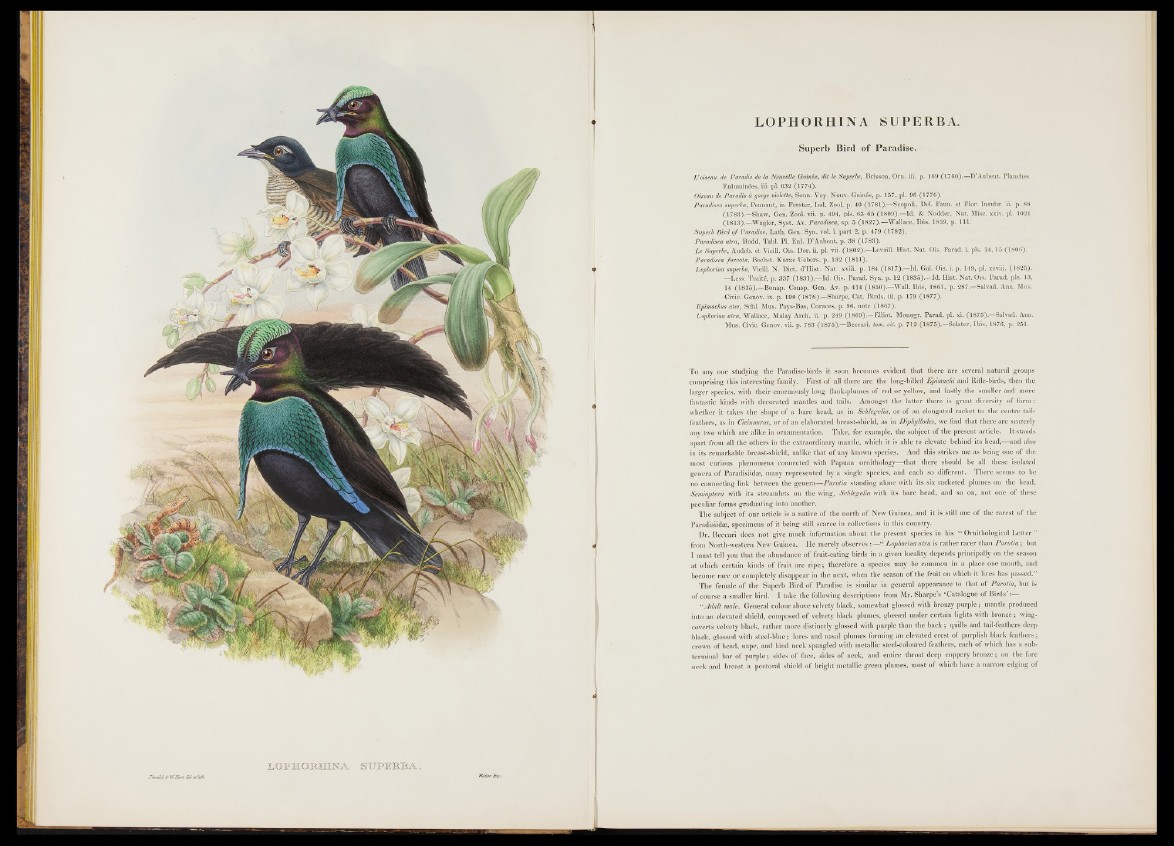
7 LQBHORHINA. . SUPERBA.. Voller Jinp.
LOPHORHINA SUPERBA.
Superb Bird of Paradise.
L’oiseau de Paradis de la Npuvellq, Guinée, dit le. Sujjerbe, Brisson, Ora. iii. p. 169 (1 7 6 0 ).—D’Aubent. Planches
Enluminées,, iii. pi. 632 (17 7 4 ).
Oiseau de Paradis à gorge violette, Sonn. Voy. Nouv. Guinée, p. 157, pi. 96 (1776).
Paradisea superba, Pennant, in Forster, Ind. Zool, p. 40 (17 8 1 ).—Scopoli, Del. Faun, et Flor. Insubr. ii. p. 88
(17 8 3 ).—Shaw, Gen. Zool. vii. p. 494, pis. 63-65 (1 8 0 9 ).—Id. & Nodder, Nat. Misc. xxiv. pi. 1021
(1 8 1 3 ).—Wagler, Syst. Av. Paradisea, sp. 5 (1 8 2 7 ).—Wallace, Ibis, 1859, p. 111.
Superb Bird o f Paradise, Latb. Gen. Syn. vol. i. part 2, p. 479 (1 7 8 2 ).
Paradisea atra, Bodd. Tabl. PI. Enl. D ’Aubent. p. 38 (1783).
Le Superbe, Audeb. et Vieill. Ois. Dor. ii. pi. vii. (1 8 0 2 ).—Levaill. Hist. Nat. Ois. Parad. i. pis. 14,15 (1806).
Paradisea furcata, Bechst. Kurze Uebers. p. 132 (18 1 1 ).
Lophorina superba, Vieill. N. Diet. d’Hist. Nat. xviii. p. 184 (18 1 7 ).—Id. Gal. Ois. i. p. 149, pi. xcviii. (18 2 5 ).
—Less. Traité, p. 337 (18 3 1 ).—Id. Ois. Parad. Syn. p. 12 (1 835).—Id. Hist. Nat. Ois. Parad. pis. 13,
14 (1 8 3 5 ).—Bonap. Consp. Gen. Av. p. 414 (1 8 5 0 ).—Wall. Ibis, 1861, p. 287.—Salvad. Ann. Mus.
Civic. Genov, ix. p. 190 (1 8 7 6 ).—Sharpe, Cat. Birds, iii. p. 179 (1877).
Epimachus ater, Schl. Mus. Pays-Bas, Coraces, p. 96, note (18 6 7 ).
Lophorina atra, Wallace, Malay Arch. ii. p. 249 (18 6 9 ).—Elliot, Monogr. Parad. pi. xi. (18 7 3 ).—Salvad. Ann.
Mus. Civic. Genov, vii. p. 783 (18 7 5 ).—Beccari, tom. cit. p. 712 (18 7 5 ).—Sclater, Ibis, 1876, p. 251.
To any one studying the Paradise-birds it soon becomes evident that there are several natural groups
comprising this interesting family. First o f all there are the long-billed Epimachi and Rifle-birds, then the
larger species, with their enormously long flank-plumes of red or yellow, and lastly the smaller and more
fantastic kinds with decorated mantles and tails. Amongst the latter there is great diversity o f form :
whether it takes the shape o f a bare head, as. in Schlegelia, or o f an elongated racket to the centre tail-
feathers, as in Cicinnurus, or o f an elaborated breast-shield, as in Diphyllodes, we find that there are scarcely
any two which are alike in ornamentation. Take, for example, the subject o f the present article. It stands
apart from all the others in the extraordinary mantle, which it is able to elevate behind its head,-—and also
in its remarkable breast-shield, unlike that o f any known species. And this strikes me as being one o f the
most curious phenomena connected with Papuan ornithology—that there should be all these isolated
genera o f Paradisiidse, many represented by a single species, and each so different. There seems to he
no connecting link between the genera—Parotia standing alone with its six racketed plumes on the head,
Semioptera with its streamlets on the wing, Schlegelia with its bare head, and so on, not one o f these
peculiar forms graduating into another.
The subject o f our article is a native o f the north of New Guinea, and it is still one of the rarest of the
Paradisiidse, specimens o f it being still scarce in collections in this country.
Dr. Beccari does not give much information about the present species in his “ Ornithological Letter ”
from North-western New Guinea. He merely observes:—“ Lophorina atra is rather rarer than Parotia; but
I must tell you that the abundance o f fruit-eating birds in a given locality depends principally on the season
at which certain kinds o f fruit are ripe; therefore a species may be common in a place one mouth, and
become rare or completely disappear in the next, when the season o f the fruit on which it lives has passed.
The female o f the Superb Bird o f Paradise is similar in general appearance to that of Parotia, but is
o f course a smaller bird. I take the following descriptions from Mr. Sharpe’s ‘Catalogue o f Birds’:—
“A dult male. General colour above velvety black, somewhat glossed with bronzy purple; mantle produced
into an elevated shield, composed o f velvety black plumes, glossed under certain lights with bronze; wing-
coverts velvety black, rather more distinctly glossed with purple than the back ; quills and tail-feathers deep
black, glossed with steel-blue; lores and nasal plumes forming an elevated crest of purplish black feathers;
crown of head, nape, and hind neck spangled with metallic steel-coloured feathers, each o f which has a subterminal
bar of purple; sides o f face, sides o f neck, and entire throat deep coppery bronze; on the fore
neck and breast a pectoral shield o f bright metallic green plumes, mostrof which have a narrow edging of